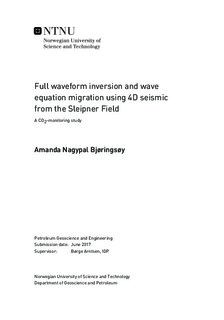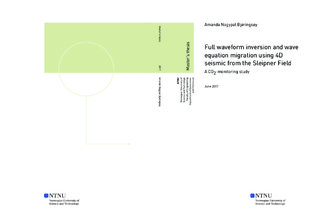| dc.description.abstract | In this study, two surveys from the Sleipner field in the North Sea are investigated. The surveys cover the same area, but are acquired at different times - respectively before and after the initiation of CO2 injection. Since the first injection started in 1996, prominent reflectivity changes as well as large velocity pushdown-effects are observed in the seismic data as a result of the seismic waves traveling slower through the injected gas. The main objectives in this thesis have been to build high-resolution velocity models through acoustic full waveform inversion (FWI) and accurate positioning the subsurface reflectors with one-way wave equation migration (WEM).
The FWI is based on the full wavefield modeling and aims to estimate high-resolution velocity models, by minimizing the difference between observed and modeled data. For this study, the FWI started with a smoothed 1-D velocity model with no lateral changes over the entire dataset. Using refracted energy to update the unknown subsurface velocity, frequency from 2Hz up to 12Hz were gradually included in the FWI iterations. A background model without the low-velocity gas zone was extracted from the inversion. Colored inversion was used to include the low gas velocities into the model. The two velocity models- with and without the gas zone were then used as input for migration. In contrast to ray-traced migration methods, the WEM is able to handle unsmoothed detailed velocity models for imaging large velocity anomalies. When migrating the monitor data with the colored inversion model, we observed reduced moveout in gathers, thinner layers as well as flatter horizons within the gas plume, compared to migration with the background model. Migration with the colored inversion model also reduced the observed pushdown-effect seen below the gas plume.
A simplified 4D matching of the base and monitor survey was performed prior to the time-lapse study. As the migrated data contained multiples and showed large acquisition footprints, noise and small artifacts in the migrated image may have been magnified as a time-lapse response. This was important to keep in mind when interpreting the time-lapse results. Nevertheless, the CO2 response itself was very clear, indicating strong confidence in the time-lapse observations. No indication of high amplitude changes in the overburden above the gas was observed, and consequently, no leakage of CO2 had occurred. | |

